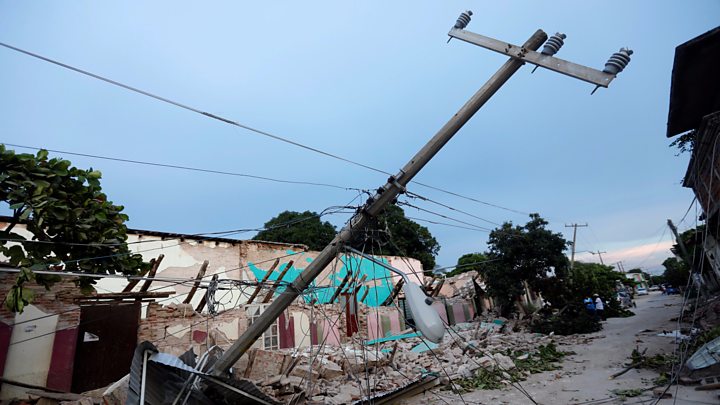Strongest Earthquake To Hit Mexican Region In A Century
>Mexico earthquake: Death toll rises as rescue effort begins
The number of people killed by a powerful earthquake off the southern coast of Mexico has risen to at least 61, officials say.
A huge rescue operation is under way in the worst-hit states of Tabasco, Oaxaca and Chiapas where people are feared trapped under rubble.
President Enrique Peña Nieto says at least 200 people have been injured.
The 8.1-magnitude quake, which hit late on Thursday, was the strongest to hit the region in a century.
President Peña Nieto has declared a day of mourning, saying flags would fly at half mast out of respect for the dead and bereaved.
The president said 45 deaths had been reported in Oaxaca, 12 in Chiapas and four in Tabasco.
One of the worst hit towns was Juchitán, in Oaxaca, where at least 17 deaths have been reported. The town hall and a number of other buildings were destroyed or badly damaged.
 EPA – President Enrique Peña Nieto speaks in Juchitán on Friday
EPA – President Enrique Peña Nieto speaks in Juchitán on Friday
“The situation is Juchitán is critical; this is the most terrible moment in its history,” said Mayor Gloria Sanchez.
President Peña Nieto visited the town on Friday.
The BBC’s Arturo Wallace says the affected region is the poorest and least developed part of Mexico and the full extent of the damage is yet to become clear.
At least one other person was killed in Guatemala, its president has said.
The huge quake struck at 23:50 local time on Thursday (04:50 GMT Friday), shaking buildings and causing panic hundreds of miles away in the capital, Mexico City.
 EPA – Parts of the town hall in Juchitán were levelled
EPA – Parts of the town hall in Juchitán were levelled
 EPA – Patients at a hospital in Villahermosa, Tabasco state, were moved into the open after the quake struck
EPA – Patients at a hospital in Villahermosa, Tabasco state, were moved into the open after the quake struck
It also triggered a tsunami warning and the evacuation of thousands of people in coastal communities in Chiapas. The warning was later lifted.
Throughout Friday, the region was shaken with scores of aftershocks.
President Peña Nieto’s office said he would travel to Chiapas to survey the damage.
Pope Francis, addressing an open air Mass on a visit to Colombia, said he was praying “for those who have lost their lives and their families”.
The earthquake was more powerful than the 1985 tremor that hit close to Mexico City and caused thousands of deaths. Correspondents say the death toll appears to have been lower because it struck less populated areas.


A bowling alley shakes in Tuxtla Gutierrez, 240km from the epicentre
Journalist Franc Contreras, who was in Mexico City, told the BBC: “You could hear loud cracks in the concrete. It sounded like a giant wooden branch being just broken open violently.
“People were streaming out of the hallways. And everybody walking out single file into the streets, trying to avoid overhead power lines.”
The quake struck as Mexico faces the threat of Hurricane Katia on its eastern coast.
The category one hurricane is south-east of Tampico and has sustained winds of 140km/h the US National Hurricane Center says.
Inevitable tremors
Jonathan Amos, BBC science correspondent
This is the biggest quake experienced anywhere in 2017. Going on the statistics, you would expect at least one magnitude eight to occur somewhere on the planet each year.
It occurred where the Pacific ocean floor is drawn under Mexico and Guatemala. A great slab of rock, known as the Cocos tectonic plate, is driving towards the coast at a rate of 75mm per year. As it jerks downwards into the Earth’s interior, about 200km offshore, large tremors are the inevitable outcome.
There have been three magnitude sevens in 2017, with a 7.9 recorded deep under Papua New Guinea back in January. This latest event, being an 8.2, is nearly three times as energetic. That tells you something about how the magnitude scale works.
Fortunately, this event was deep, too. The rupture, which will have ripped across more than 100km of fault line, was down at 70km. That will have limited some of the shaking, but as we’ve seen there is still extensive damage.
